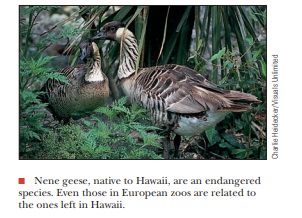Chapter: Biochemistry: Nucleic Acids: How Structure Conveys Information
The DNA Family Tree
The DNA Family Tree
Because
it is easy to determine the sequence of DNA, even using automated and robotic
systems that require little supervision, the amount of DNA sequence data
available has virtually exploded. Many scientific journals no longer report
full sequences; the information is just incorporated into so-called gene banks,
large computer systems that store the data.
The
sequence information, for proteins as well as for DNA, is read-ily available to
anyone with a web search program. See http://www.tigr.org (the J. Craig Venter
Institute) for genomic databases and http://expasy.hcuge.ch (the ExPASy
molecular biology server main-tained by Geneva University Hospital and the
University of Geneva). The ExPASy site is a repository for information about
protein sequenc-es as well as DNA sequences. A particularly useful site is
http://www.genome.gov, maintained by the National Human Genome Research
Institute of the National Institutes of Health. Another government-sponsored
site is http://genomics.energy.gov, one of the most impor-tant repositories of
results of the Human Genome Project. So much information is entered into the
databanks that it has become neces-sary to develop new and more efficient
computer technology to search and to compare such sequences. We are just beginning
to appreciate the usefulness of so much information. Many new applications, not
even thought of at this time, will undoubtedly be developed. Here are two
applications that give molecular information about evolution, the “family tree”
of all living things.
Molecular taxonomy. In ways never before possible, we can com-pare the sequences not just from existing organisms but also, when DNA is available from fossil specimens, from extinct ances-tors of living organisms. Within given genetic families of limited size, this information has enabled very detailed evolutionary trees to be developed.

It has been possible to show that, in some areas, all plants are clones of one
another. The largest living organism is a soil fungus that spreads over several
acres. Redwood trees grow as clones from a central root system after forest
fires. Sadly, many endangered species have such small remaining numbers that
all living specimens are closely related to each other. This is true for all
nene geese, which are native to Hawaii; for all Cali-fornia condors; and even
for some whale species. The lack of genetic diversity in these endangered
species may mean that the species are doomed to extinction, in spite of human
attempts to ensure their survival.
Ancient DNA. DNA has been isolated from
human fossils, suchas mummies, bog people, and the frozen man found in the
Alps, allowing comparisons of modern humans to recent rela-tives. Mitochondrial
sequencing has shown that all humans now alive radiated out from one region in
Africa some 100,000 to 200,000 years ago. More ancient DNA sequences from
insect specimens preserved in amber have been com-pared to their modern
counterparts. The film Jurassic Park
is based on the suggestion that dinosaurs might be cloned from the DNA in their
blood, which survived in the gut of an insect preserved in amber-certainly a
far-fetched possibility, although entertaining (and profitable to filmmakers).
The acceptance of DNA sequence data from ancient DNA is still controversial
because of the likelihood of DNA degradation over time, contamination with
modern DNA, and damage due to the initial chemical treatment of the samples.

Related Topics